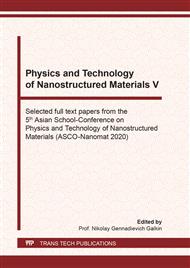[1]
J.M. Ziman, Models of Disorder The Theoretical Physics of Homogeneously Disordered Systems, Cambridge Univ. Press, London, (1979).
Google Scholar
[2]
G.E. Abrosimova, Evolution of the structure of amorphous alloys, Physics-Uspekhi. 54 (2011) 1227–1242.
DOI: 10.3367/ufne.0181.201112b.1265
Google Scholar
[3]
G. Herzer, Modern soft magnets: Amorphous and nanocrystalline materials, Acta Mater. 61 (2013) 718–734.
DOI: 10.1016/j.actamat.2012.10.040
Google Scholar
[4]
R.C. O'Handley, Physics of ferromagnetic amorphous alloys, J. Appl. Phys. 62 (1987) R15–R49.
Google Scholar
[5]
M.E. McHenry, M.A. Willard, D.E. Laughlin, Amorphous and nanocrystalline materials for applications as soft magnets, Prog. Mater. Sci. 44 (1999) 291–433.
DOI: 10.1016/s0079-6425(99)00002-x
Google Scholar
[6]
E. V. Pustovalov, E.B. Modin, A.M. Frolov, A.S. Kosovets, N.B. Kondrikov, N.F. Karpovich, S.A. Pyachin, S. V. Dolzhikov, G.S. Kraynova, V.S. Plotnikov, V. V. Tkachev, A.N. Fedorets, N. V. Ilin, Effect of the Process Conditions for the Preparation of CoNiFeSiB Amorphous Alloys on Their Structure and Properties, J. Surf. Investig. X-Ray, Synchrotron Neutron Tech. 13 (2019) 600–608.
DOI: 10.1134/s1027451019040128
Google Scholar
[7]
M.A. Willard, M. Daniil, Nanocrystalline Soft Magnetic Alloys Two Decades of Progress, in: K.H.J. Buschow (Ed.), Handb. Magn. Mater., North Holland, 2013: p.173–342.
DOI: 10.1016/b978-0-444-59593-5.00004-0
Google Scholar
[8]
S.V. Komogortsev, R.S. Iskhakov, Law of approach to magnetic saturation in nanocrystalline and amorphous ferromagnets with improved transition behavior between power-law regimes, J. Magn. Magn. Mater. 440 (2017) 213–216.
DOI: 10.1016/j.jmmm.2016.12.145
Google Scholar
[9]
R.S. Iskhakov, S. V. Komogortsev, Magnetic microstructure of amorphous, nanocrystalline, and nanophase ferromagnets, Phys. Met. Metallogr. 112 (2011) 666–681.
DOI: 10.1134/s0031918x11070064
Google Scholar
[10]
S. V. Komogortsev, G.S. Kraynova, N. V. Ilin, V.S. Plotnikov, L.A. Chekanova, I. V. Nemtsev, G.Y. Yurkin, R.S. Iskhakov, D.A. Yatmanov, Ferromagnetic resonance in amorphous FeSiBNbCu ribbons of various composition, Mater. Sci. (2019) 8–11.
DOI: 10.1134/s2075113320010219
Google Scholar
[11]
N. V. Ilin, A.K. Tcesarskaia, V. V. Tkachev, V.A. Ivanov, A.M. Frolov, S. V. Dolzhikov, G.S. Kraynova, V.S. Plotnikov, Effect of composition on the structural relaxation of amorphous iron-based alloys, Bull. Russ. Acad. Sci. Phys. 81 (2017) 387–390.
DOI: 10.3103/s1062873817030169
Google Scholar
[12]
Glezer, A.M. and Shurygina, N.A., Amorfno-nanokristallicheskie splavy (Amorphous Nanocrystalline Alloys), Moscow: Fizmatlit, (2013).
Google Scholar
[13]
A. Hubert, R. Schäfer, Magnetic Domains, Springer Berlin Heidelberg, Berlin, Heidelberg, (1998).
Google Scholar
[14]
R. Schäfer, Domains in extremely, soft magnetic materials, J. Magn. Magn. Mater. 215–216 (2000) 652–663.
DOI: 10.1016/s0304-8853(00)00252-3
Google Scholar
[15]
S.W. Lovesey, The Theory of Neutron Scattering from Condensed Matter: Volume 2, Oxford University Press, Oxford, (1984).
Google Scholar
[16]
J. Weissmuller, R.D. McMichael, A. Michels, R.D. Shull, Small-angle neutron scattering by the magnetic microstructure of nanocrystalline ferromagnets near saturation, J. Res. Natl. Inst. Stand. Technol. 104 (1999) 261.
DOI: 10.6028/jres.104.019
Google Scholar
[17]
F.E. Luborsky, J.L. Walter, H.H. Liebermann, E.P. Wohlfarth, The effect of temperature on magnetic saturation of some amorphous alloys, J. Magn. Magn. Mater. 15–18 (1980) 1351–1354.
DOI: 10.1016/0304-8853(80)90318-2
Google Scholar
[18]
G. Herzer, Nanocrystalline Materials: Magnetism, in: Encycl. Mater. Sci. Technol., Elsevier, 2001: p.5897–5901.
Google Scholar
[19]
L.P. Tarasov, Ferromagnetic Anisotropy of Iron and Iron-Rich Silicon Alloys, Phys. Rev. 56 (1939) 1231–1240.
DOI: 10.1103/physrev.56.1231
Google Scholar


